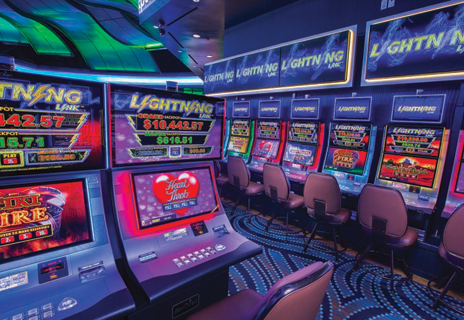Hold for Gold, Spin to Win

Since the early 1980s, modern slots have accounted for the lion’s share of gaming revenues in every market that they operate in. The brightest minds and most successful companies in the industry have long thrown their full weight behind researching and developing the most innovative game features, and players have rewarded these efforts handsomely.
At its core, slot design is a process rooted in psychology—the complex mathematical foundation of games and their beautiful artistic flair are really just attempts to delve into the minds of players and understand what makes them tick.
Over the years, this research has concluded time and time again that above all, players love persistence.
Games with true or perceived persistence are those that increase or seem to increase in quality over time and build gradually towards some kind of jackpot or bonus reward. There have been many successful iterations of persistence games, but one mechanic that has proven to be especially prolific is the hold-and-spin bonus.
Hold-and-spin-style games, as the name suggests, are those that feature special bonus events that operate like so: After a player collects a given number of symbols—most often coins, gems or something of value—a bonus is triggered in which the symbols remain in place while the player is allotted three spins. The symbols often bear a certain credit amount (known as cash on reels), and every time another one lands, the spin count is reset to three.
The bonus continues until the spin count is exhausted, at which point the sum of the credit amounts is awarded. A special prize, usually a progressive jackpot, is awarded for filling all the reel spots.
A Gradual Evolution and a Lightning Strike
This particular feature has become a must-have for all major suppliers’ current portfolios, but the concept is reminiscent of other, earlier game mechanics.
According to Buddy Frank, longtime slot executive and principal at BF Slot Strategies, the inspiration for modern hold-and-spin games can be traced all the way back to the 1930s, when “skill stop” machines were first introduced.
“Essentially, (skill stops) were mechanical three-wheel machines that had little buttons up on the top of the cabinet, and if one of the wheels had a winning symbol on it, you pushed down the skill stop and it held that wheel while you spun the game again to see if you’d get more,” he explains. “In a way, that is hold-and-spin as we know it, but it obviously updated dramatically with the use of technology.”
From there, Frank notes that the mechanic further evolved with the advent of draw poker games, most notably Triple Play Poker from video poker pioneer Ernie Moody. The game allowed players to hold winning cards on three hands at once, which is again reminiscent of the type of persistence that hold-and-spin has evolved into.
“People love it when they can do something that they think improves their chances of winning in the future,” Frank posits. “Certainly skill stops are like that, draw pokers are like that… It’s hard not to get excited when you see something that gives you a perceived advantage in the future. It stimulates people to play more and more as the excitement builds until you reach an ultimate bonus, and it almost feels like you can’t lose once you get into one of those.”
Over time, these earlier iterations eventually morphed into the current era of games. Exact origins and influences may be up for debate, but the one game that is widely credited with kickstarting this current hold-and-spin craze is Aristocrat’s 2014 smash hit Lightning Link, the brainchild of Hall of Fame slot designer Scott Olive.
Victor Duarte, executive vice president of gaming product for Aristocrat, notes that Olive “had worked on iterations of (hold-and-spin) in earlier games,” but everything fell into place “with the creation of Lightning Link, and forever changed the industry.”
In 2017, Olive and his team at HRG Studios further revolutionized hold-and-spin with the release of Dragon Link. The two franchises, Duarte notes, are now the “highest-yielding game families in the industry.” In the Eilers & Krejcik Gaming (EKG) Game Performance Report for May 2024, Dragon Link and Lightning Link still ranked first and second for top-grossing core games in the premium leased category, several years after their initial releases.
Dragon Link alone accounted for 31.6 percent of the theoretical win for the category, which matched the total of the next four spots combined.
“We believe players respond so well to (hold-and-spin) because of its simplicity,” Duarte says. “Players naturally understand the potential values in the bonus feature and build anticipation as the re-spins continue and re-trigger. Of course, the elegant presentation, math, sound and other game elements are not simple to create, and that is why HRG’s games have the complete package that is incomparable.”
Olive himself would echo this sentiment—he told GGB in 2022 that with hold-and-spin, “what you see is what you get.” Players can see what it is they’re working towards, and this ties back to Frank’s point about building excitement during the game. This clarity of focus, Olive explained, is why the games are so successful.
“Simplicity is the secret ingredient for the best and most enduring games,” he said.
Opening the Floodgates
As with any successful trend in gaming, the influence of Aristocrat’s hold-and-spin games has for several years now inspired virtually all other major suppliers to follow suit.
But the increase in the amount of games has done little to suppress their overall success. Frank notes that EKG data for the fourth quarter of 2023 showed that games with hold-and-spin combined with feature combos performed at an average index of 1.82, or 182 percent of house average. Hold-and-spin combined with free games performed at an index of 1.22.
“You can see that these games are very, very popular no matter who manufactures them,” he asserts.
IGT—which refers to the mechanic as lock-and-respin—has released a number of its best-performing titles from recent years with this feature, including Prosperity Link and Mystery of the Lamp. Its latest big release featuring hold-and-spin, Tiger and Dragon, debuted in May at No.1 in EKG’s top indexing new premium leased and wide-area progressive category.
“The lock-and-respin mechanic has proven to be very popular with players in themes across IGT’s land-based and online gaming portfolio,” says Dubravka Burda, senior vice president of global studios. “The lock-and-respin mechanic has evolved significantly over the past years, with many paths available to trigger the feature. Lock-and-respin combined with persistence has also gained popularity, and features persistence cycles during game play that are supplemented with visual and audio indicators to elevate the experience.”
Burda explains that the company has evolved its strategy to add more layers to the feature over the years to make it more sophisticated, “as players are looking for more events” during their game play.
Tiger and Dragon, for example, introduces “an entirely new lock-and-respin and reveal bonus structure featuring money ball symbols with credit values that can combine,” she says.
Light & Wonder (L&W) has been another successful member of the hold-and-spin party, also releasing a number of staple games featuring this mechanic in the last few years. One of its biggest recent releases, Huff N’ Even More Puff, was May’s top overall performer in the core low denom, video reel category, per EKG. Additionally, three different variations of its Dragon Train series also placed in the top 25 of the new premium leased and wide-area progressive category for the same period.
According to Vice President of Product Management Dirk Geere, L&W “is continually evolving and innovating game features and functionality, particularly with the popular hold-and-spin feature.”
Geere points out that Huff N’ Even More Puff “showcases a highly evolved hold-and-spin game mechanic,” one with “elevated levels of achievement” within the feature itself.
Even Aristocrat, whose new and old titles litter the leaderboards, is continuing to hone its hold-and-spin techniques to adapt to changing player preferences. Earlier this year, the company took home its sixth consecutive title as Best Overall Supplier of Slot Content at the annual EKG Slot Awards, but that hasn’t stopped its desire to innovate.
“We continue to evolve the hold-and-spin mechanic across new games and series, including the most recent launch of Lightning Dollar Link, and customers and players can expect to see more as we head towards G2E and beyond,” Duarte says.
Fan Favorite
Few trends in the slot world have had a higher approval rating across demographics, markets and verticals than hold-and-spin games. The suppliers may vary but the appetite for the bonuses is virtually universal, which is rare to find given that there tends to be one overarching aspect of a game type that aligns it with a particular base.
Hold-and-spin, by contrast, has distinguished itself as being uniquely additive to virtually any game—as Frank says, “the mechanic itself is positive and almost any machine that has it seems to be better” than the ones that don’t. Its Australian roots have blossomed into a truly global phenomenon.
“Some of the original hold-and-spin came out of Australia, but now almost everybody has studios worldwide, everywhere from Austin, Texas to Reno, Nevada to Vegas to Boston, so it’s becoming more universal,” Frank explains.
On its own, hold-and-spin can make a decent game great, but when the rest of the aspects of a game are well executed, that’s when things really start to get transformative.
Burda contends that today’s players value several different factors in a game, including “the art, audio, and graphics, the depth of the game mathematically and the cabinet,” meaning that one mechanic of a game cannot be relied on to make up for the other variables.
But here the simplicity of hold-and-spin shines through again, in the sense that it’s just a fun and exciting addition to a game, a timeless quality that appeals directly to the overall ethos of slot play.
“Players love it because it’s highly entertaining from both a base game and feature perspective,” she says. “Having many opportunities to win in a game through the lock-and-respin mechanic and progressive functionalities combined is very attractive to players.”
Geere notes that overall, “players today seek more excitement and entertainment in their gaming experiences,” and “the hold-and-spin feature meets this demand by providing an elevated experience similar to free games, which has contributed to its widespread popularity in the industry.”
Additionally, he posits that the feature is a hit with today’s players because “it injects a moment of heightened excitement into the game,” coupled with a “concentrated time frame, during which players know they only have a limited number of spins to potentially win big.” This goes a long way in “adding an extra layer of thrill” to the overall experience.
The performance of hold-and-spin games over the last decade is undeniable, both on the charts and on the floors of just about every casino in the industry. Moving forward, the biggest question will not revolve around suppliers’ ability to produce the games, but will instead center on players’ willingness to continue playing them at a high level. And if and when a new trend emerges, the next generation of designers will work to create the next classics.
“Hold-and-spin is one of those that right now is dominant, but will that change? Hell yeah,” Frank says. “Players are constantly evolving, people find something new they like and move on… It’s one of those magical things in slots where everything has to come together at the right time.”

